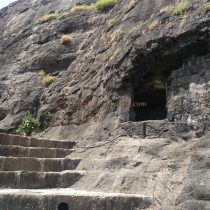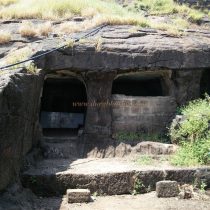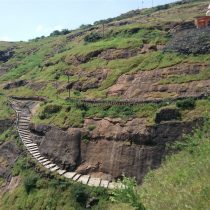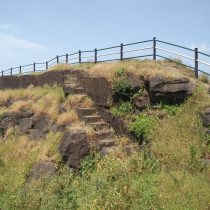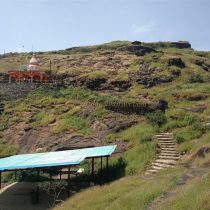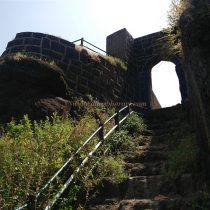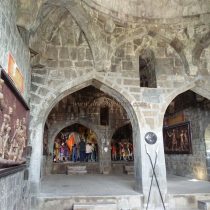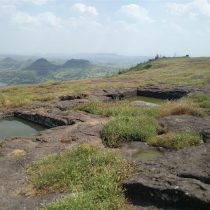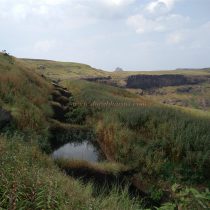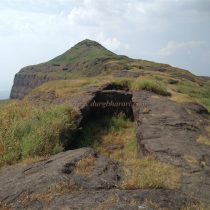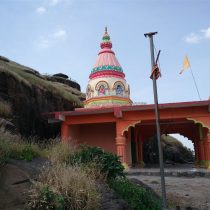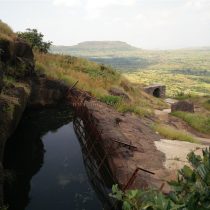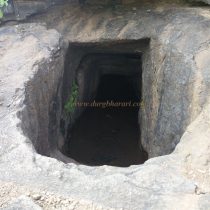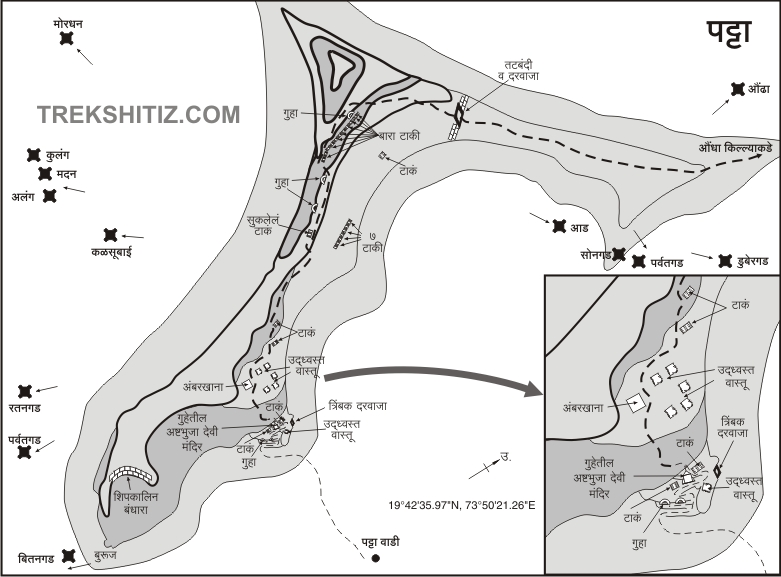PATTAGAD
TYPE : HILL FORT
DISTRICT : NAGAR
HEIGHT : 4396 FEET
GRADE : EASY
Kalsubai mountain range in Akole taluka is well known. Aundha, Patta, Aad, and Bitanggad forts are situated to the east of this mountain range. Among all these forts, Patta is more fortunate than others because Shivaji Maharaj, the founder of Swarajya had stayed on this fort for some time. Patta fort is located between Bitangad and Aundha. This fort on the border of Nagar and Nashik districts still stands strong. This fort is also known as Vishramgad as Shivaji Maharaj had stayed on it for some time. There are three ways to get to the fort. The easiest and closest way is to pass through the village of Pattawadi, which is at the foot of the fort on the east side. The second route from Konkanwadi village to the south of the fort takes you to the fort but this route is relatively difficult while the third route leads up from the path between Aundha and Patta forts.
...
Among these three routes, the third one is the hardest. The first way to reach the fort is on the Ghoti-Bhandardara road leading to Taked village. Konkanwadi fork is 9 km from Taked village via Mahismal Ghat. Pattawadi is at a distance of 8 km from Konkanwadi fork at the foot of Pattagad. Pattawadi is a village situated on a plateau. The height of the fort is 4566 feet above sea level and 900 feet from the base. On the way to Pattawadi, the bastions and ramparts on the two hills that come in front of Pattagad attract our attention. There is a paved road from Pattawadi to the base of the fort. At the end of this road, a ruined structure is visible on the left side. There are some carved idols under a tree next to this building. There is a forest department post at the end of this road and you can reach the fort by paying an entry fee of Rs. 5 / - and registering your name and address. As you begin to climb the fort, you will see a fiber sculpture of an elephant on a quadrangle structure on the left and a cannon mounted on a cart on the adjacent rock. After a short climb, you will see the replica of the old door which is now made out of fiber on the steps. As you ascend these steps, you can see a carved rock on the left and in some places the remains of the ramparts. When you come up the stairs, you can see a cave with a small mouth. The height of this cave is enough to crawl although it is not possible to enter this cave as it is full of water. There should be a water cistern in this cave. Going up from this cave, there are another two caves on the left. A hermit named Laxman Maharaj used to live in one of these caves. This is a Jain cave and on the wall of the cave, there is an image of Neminath on one side and a Yaksha image on the other side. The cave has two parts, a gallery, and a room, and it is forbidden to enter the room. Outside the cave, two idols of Jain deities are seen. The second cave adjacent to it is normal. Further to the right are another two caves. The larger cave has the memorial of Laxman Maharaj and the other cave has the idol of Goddess Chatushrungi. There is a water tap outside the cave and the water from the cistern above the fort is brought here by the tap. Both the caves and the spacious courtyard in front of the caves has tin shelter and there is a facility to stay in this shelter. The Forest Department of the fort has built a shelter on the bastion to rest and sit. In this area, there are ramparts and steps. After climbing the steps near the cave, the path turns left and the remains of the fort began. The north-facing Trimbak gate of the fort in front is still in good condition. There are bastions on the right side and above the entrance. The descent from here leads to Pattawadi. Seeing the Trimbak door, you go upwards and take up the steps carved in the rock. There are excavated drinking water cisterns from the Satvahan period. The water from this cistern is piped to the large cave below. Adjacent to this cistern is the temple of Goddess Pattai which is why the fort got the name "Patta". The temple has recently been renovated. There is a bastion of the fort on the hill at the back of the temple and the forest department has built a shelter on it. Going ahead in front of the temple and climbing up, you can see the remains of the houses and finally you come to a spacious stone building. This building is called Ambarkhana. The forest department has repaired Ambarkhana and a bust of Shivaji Maharaj has been installed in Meghadambari on the outside. The Amberkhana has two small doors and a flagpole outside. The roof of this building is domed and there are spacious rooms inside. In these rooms, there are many events of the battle, etc. made out of fiber and also a statue of Shivaji Maharaj sitting on the throne which is also made out of the fiber. There is a garden around the Ambarkhana. In the premises of the Ambarkhana, there are four or five quadrangle structures of other buildings. After seeing the Ambarkhana, to see the remains of the fort, start climbing from the back of Ambarkhana. The top of Patta Fort is a vast plateau. The pinnacle of Aundha fort is visible on the right side from the top of the fort. On the right side of the plateau, on the way to Aundha fort, a large water cistern is seen. The water in this cistern is potable. On our way ahead, there are two big water cisterns and a dry cistern next to it. In front of these cisterns, you can see the signs of stone being removed from here for the construction of the fort and the structures on it. You can see two paths nearby. One on the left goes to the tall part of the fort but there are no remains in this area while the other goes to the right towards the Aundha fort. This path on the right also leads to a cave. The cave has two parts, the gallery, and the room. The gallery is weighed on two pillars and the room is weighed on four pillars. Going further from this cave, you can see 7 cisterns of water carved in a row on the lower side. If you continue walking straight ahead, you will see another cave. On the outside of this cave is a granary. The granary has three entrances built of rock. As these two caves are close to water cisterns, this place can be a great place to stay on the fort. Walking ahead from these caves, you can see 12 cisterns of water one after the other. These cisterns are known as ‘Bara Taki’. Behind the last cistern is a cave carved into the rock. gutters are carved in the stone wall to draw water inside the cave. Another large cistern of water can be seen on the plateau below the twelve cisterns. There are more than 30 water cisterns on the fort. After taking this path straight towards Aundha Fort, in 15 minutes we reach the Delhi Gate facing north of Patta fort. The arch of the door has been demolished although the bastions on the side of the door remain. The ramparts leading from the gate to the lower part of the fort have collapsed. There is a large water cistern outside this door. From here you can reach Aundha fort by footpath. After looking at the door, turn around and go back to the Ambarkhana. On the left side in the upper part of the Ambarkhana are the remains of some structures. Next, you can see a dam from Shivaji Maharaj’s era and a lake. At the left end of the fort are two majestic bastions. These bastions are visible from the road when you enter the Pattawadi village. After seeing this bastion, we come to Pattadevi temple on the way down. On the way, we see another shelter built by the forest department on the bastion. This is where your fort round ends. It takes 4 hours to walk around the entire fort. Standing on the highest part of Pattagad, you can see a distant region on all sides. To the west are the forts of Kalsubai, Trimbakgad, Alang, Madan, and Kulang, to the south, are the forts of Bitangad, Mahankal Dongar and to the north are the forts of Aundha and Aad. The Konkan hill range from Patta to Aundha looks very beautiful. The rivers Mhalungi and Aadhla originate on the eastern slope of the fort. These forts were used to keep an eye on all these areas. A glance at the history of the fort reveals that the fort has a very long history. Considering the availability of water and remnants of the fort, many people might be living on the fort. Aundha and Patta forts are mentioned in Aranyakanda in Ramayan by Saint Eknath. The shape of Aundha-Patta forts is like a thumb. Therefore, it is said that when Ravan’s thumb was cut, it took place of this fort. As per this, the fort must have come into existence during the Yadav period. The fort was probably built during the reign of the Bahamani (1347 to 1490). Patta Fort is mentioned in the Bahamani Empire in the 14th century. After that, it passed to the local Mahadev Koli tribe. After the fall of the Bahamani Empire in 1490, the fort came under Nizam rule. The fort was conquered by the Mughals in 1627. In 1671, Moropant took over the fort but in 1672 the Mughals recaptured the fort. In 1675, Moropant Pingle brought Patta fort under their control in Swarajya for the second time. In the year 1679, in the last phase of the southern expedition, Chhatrapati Shivaji Maharaj plundered Jalna. According to historical records, 15th November 1679 is when Maharaj plundered Jalna. The news that Maharaj was going to Raigad with the loot reached the Mughal Sardar Ranmastkhan. With an army of ten thousand, he followed Shivaji Maharaja. The two armies met at Raitewadi near Sangamner. Enemy forces surrounded Shivaji Maharaja on three sides. On 18th, 19th, and 20th November, there was a battle between the two armies for 3 days. Out of the eight thousand people who were with Shivaji Maharaj, four thousand soldiers came to work. This was the last battle of the Maharaja's career. It was reported that a large army had been sent from Aurangabad to help Khan. During the war, it was decided to take the treasure and selected 500 cavalries with Shivaji Maharaj along with Bahirji Naik to Patta fort and the remaining army would continue the battle. After fighting the last battle of his life at Raitewadi near Sangamner, Shivaji Maharaj came to Patta fort on 21st November 1679. As the south expedition has been rough, the health of Shivaji Maharaj had deteriorated, so they stayed at this fort for 17 days. While returning, Shivaji Maharaj renamed the fort as Vishramgad. Later, till 1686, all this area was under the control of Marathas. After the death of Shivaji Maharaj, Aurangzeb came to Maharashtra in 1682 and started conquering the Maratha territory. In 1688, Matbarkhan captured many forts in Baglan. The Mughals captured Aundha, Trimbakgad, Cavani, Tringalwadi, Madangad forts of the Marathas from 1688 to 89 by betrayal but they had to conquer Pattagad by attacking it. Regarding Pattagad, Matbarkhan writes to Aurangzeb that Sevak has added a detachment of 1000 Koli, Bhill, and Mavala in the army. The landlords of the area under Pattagad and other forts under Maratha control have been bribed. On January 11, 1688, Khan conquered the fort by attaching ropes and climbing and attacking it around midnight. Govind Singh, Thanedar of Bhagur, was posted at the fort. In 1671, Madhavrao conquered Pattagad from the Mughals. Then at the start of the eighteenth century, the fort was conquered by the British from the Marathas.
© Suresh Nimbalkar



